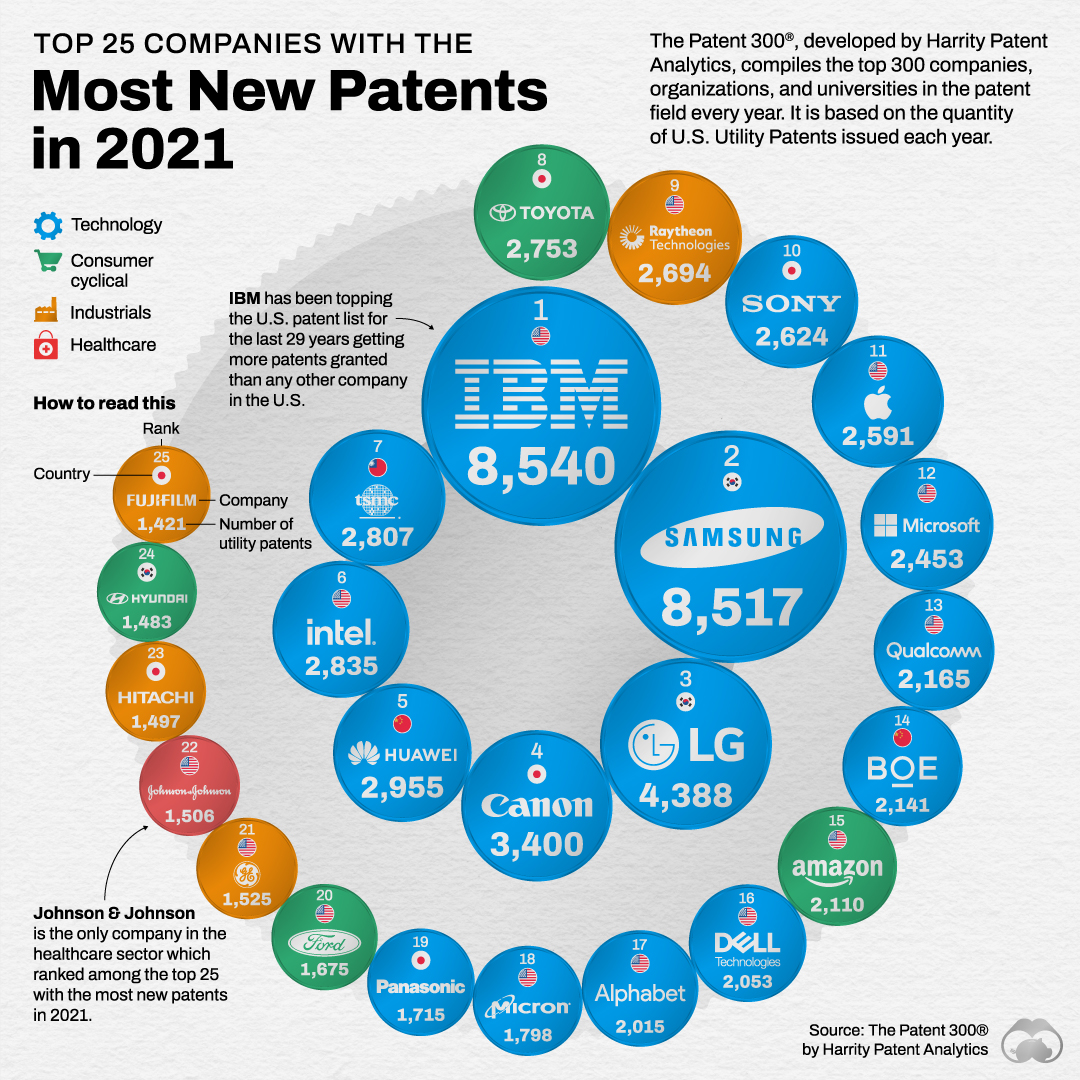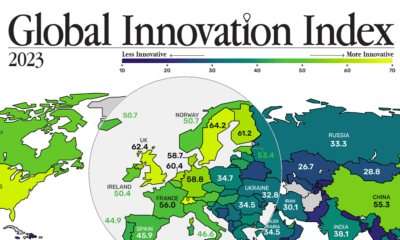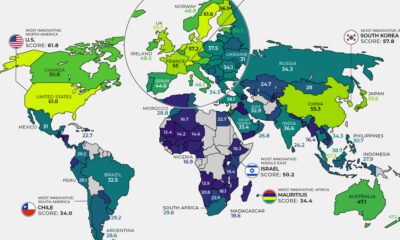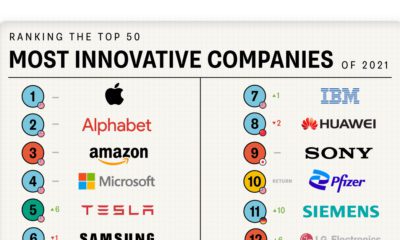Datastream
Visualizing Companies with the Most Patents Granted in 2021
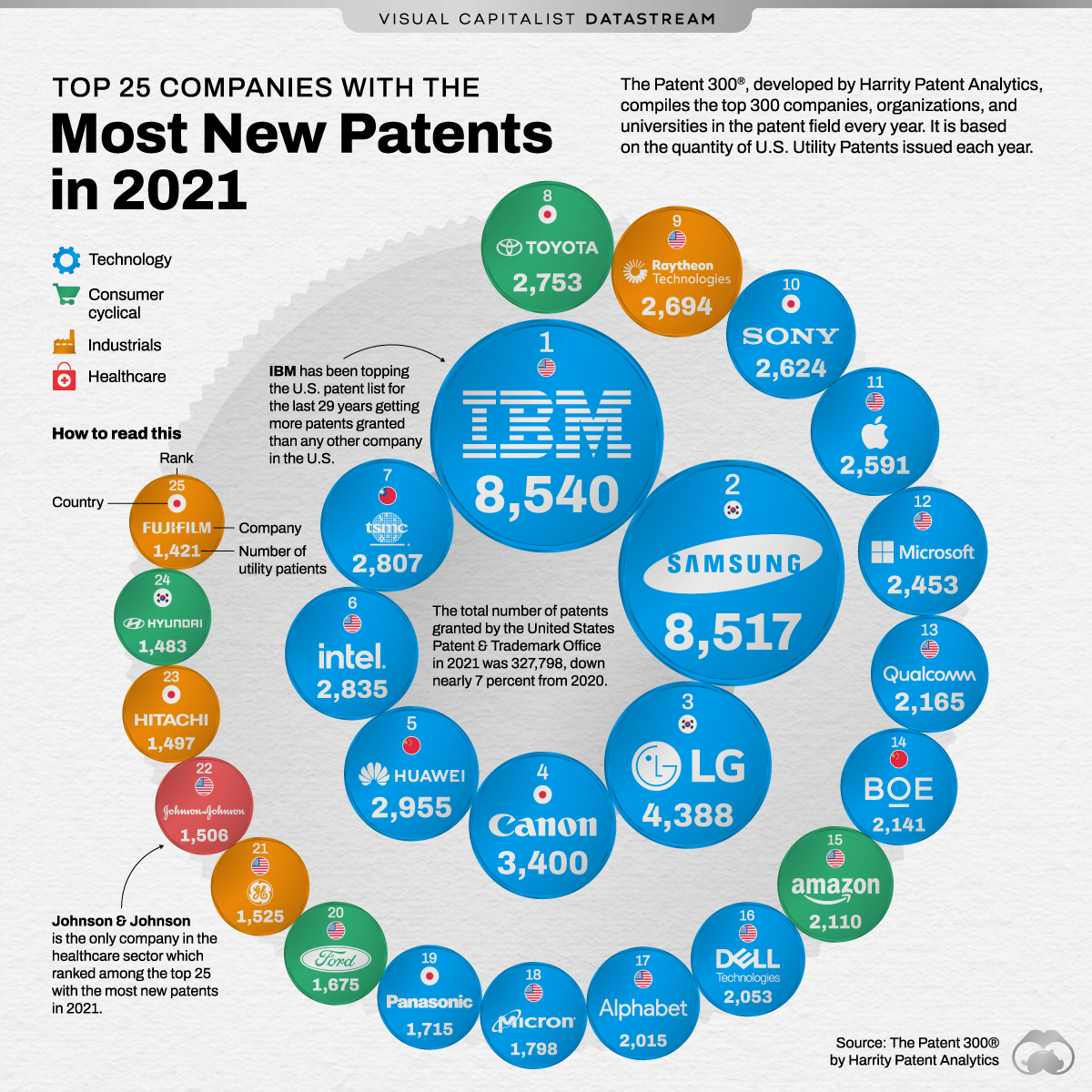
The Briefing
- In 2021, the U.S. Patent and Trademark Office (USPTO) granted a total of 327,798 utility patents
- For almost three decades, IBM has been granted more patents each year than any other U.S. company
Visualizing Companies with the Most Patents Granted in 2021
Companies around the world invest billions in R&D to provide cutting-edge innovation to their products and services. In order to protect these investments, companies apply for patents. Therefore, the number of utility patents a company is granted can be considered a rough measure of its level of innovation.
Every year, the Patent 300 List identifies America’s most innovative companies within the intellectual property space by analyzing the patents granted by the United States Patent and Trademark Office (USPTO).
In 2021, the USPTO granted a total of 327,798 utility patents, down 7% from the previous year. Let’s take a look at which companies generated the most patents in 2021.
| Rank | Country | Company/Organization | 2021 Patents | Change from 2020 |
|---|---|---|---|---|
| 1 | 🇺🇸 U.S. | International Business Machines Corporation | 8,540 | -9% |
| 2 | 🇰🇷 South Korea | Samsung Electronics Co., Ltd. | 8,517 | 0% |
| 3 | 🇰🇷 South Korea | Lg Corporation | 4,388 | -13% |
| 4 | 🇯🇵 Japan | Canon K.K. | 3,400 | -8% |
| 5 | 🇨🇳 China | Huawei Technologies Co., Ltd. | 2,955 | -7% |
| 6 | 🇺🇸 U.S. | Intel Corporation | 2,835 | -14% |
| 7 | 🇹🇼 Taiwan | Taiwan Semiconductor Mfg. Co. Ltd. | 2,807 | -3% |
| 8 | 🇯🇵 Japan | Toyota Jidosha K.K. | 2,753 | -2% |
| 9 | 🇺🇸 U.S. | Raytheon Technologies Corporation | 2,694 | -16% |
| 10 | 🇯🇵 Japan | Sony Corporation | 2,624 | -9% |
For 29 consecutive years, IBM has led U.S. companies in the number of patents received annually. In 2021, the company received 8,540 patents, a 9% decline from the previous year.
IBM’s innovations are focused on solving major global challenges, and cover areas such as sustainable growth, climate change, and preventing future pandemics, as well as initiatives enabling food and energy security. They aim to address these problems through a blend of high-performance computing, artificial intelligence (AI), and quantum computing.
One of IBM’s most noteworthy innovations in 2021 was their new quantum processor called Eagle, which broke the 100-qubit barrier to bring quantum computing into a new era. This processor has the ability to solve problems that classical computers can’t, giving it the potential to bring real-world benefits to different fields from renewable energy to finance and more.
Samsung: A Close Second Innovator
Samsung Electronics is one of the biggest innovators over the last decade. In 2021, the company got 8,517 patents granted by the USPTO, a close second to IBM.
The company’s patent-winning innovations take place in several areas, including virtual and augmented reality (VR/AR), artificial intelligence and machine learning (AI/ML), 5G technologies, and autonomous driving.
The Technology Sector Dominates Utility Patents
Unsurprisingly, out of the top 25 companies with the most patents granted in 2021, 16 of them belong to the technology sector.
However, utility patents are not only limited to tech companies.
In fact, companies from all sectors apply for patents every year. Patents are great assets for companies since they give them exclusive commercial rights for their inventions and protect them from competition. This is one of the main reasons we see companies getting thousands of new patents every year.
Source: The Patent 300®, developed by Harrity Patent Analytics
Datastream
Can You Calculate Your Daily Carbon Footprint?
Discover how the average person’s carbon footprint impacts the environment and learn how carbon credits can offset your carbon footprint.

The Briefing
- A person’s carbon footprint is substantial, with activities such as food consumption creating as much as 4,500 g of CO₂ emissions daily.
- By purchasing carbon credits from Carbon Streaming Corporation, you can offset your own emissions and fund positive climate action.
Your Everyday Carbon Footprint
While many large businesses and countries have committed to net-zero goals, it is essential to acknowledge that your everyday activities also contribute to global emissions.
In this graphic, sponsored by Carbon Streaming Corporation, we will explore how the choices we make and the products we use have a profound impact on our carbon footprint.
Carbon Emissions by Activity
Here are some of the daily activities and products of the average person and their carbon footprint, according to Clever Carbon.
| Household Activities & Products | CO2 Emissions (g) |
|---|---|
| 💡 Standard Light Bulb (100 watts, four hours) | 172 g |
| 📱 Mobile Phone Use (195 minutes per day)* | 189 g |
| 👕 Washing Machine (0.63 kWh) | 275 g |
| 🔥 Electric Oven (1.56 kWh) | 675 g |
| ♨️ Tumble Dryer (2.5 kWh) | 1,000 g |
| 🧻 Toilet Roll (2 ply) | 1,300 g |
| 🚿 Hot Shower (10 mins) | 2,000 g |
| 🚙 Daily Commute (one hour, by car) | 3,360 g |
| 🍽️ Average Daily Food Consumption (three meals of 600 calories) | 4,500 g |
| *Phone use based on yearly use of 69kg per the source, Reboxed | |
Your choice of transportation plays a crucial role in determining your carbon footprint. For instance, a 15 km daily commute to work on public transport generates an average of 1,464 g of CO₂ emissions. Compared to 3,360 g—twice the volume for a journey the same length by car.
By opting for more sustainable modes of transport, such as cycling, walking, or public transportation, you can significantly reduce your carbon footprint.
Addressing Your Carbon Footprint
One way to compensate for your emissions is by purchasing high-quality carbon credits.
Carbon credits are used to help fund projects that avoid, reduce or remove CO₂ emissions. This includes nature-based solutions such as reforestation and improved forest management, or technology-based solutions such as the production of biochar and carbon capture and storage (CCS).
While carbon credits offer a potential solution for individuals to help reduce global emissions, public awareness remains a significant challenge. A BCG-Patch survey revealed that only 34% of U.S. consumers are familiar with carbon credits, and only 3% have purchased them in the past.
About Carbon Streaming
By financing the creation or expansion of carbon projects, Carbon Streaming Corporation secures the rights to future carbon credits generated by these sustainable projects. You can then purchase these carbon credits to help fund climate solutions around the world and compensate for your own emissions.
Ready to get involved?
>> Learn more about purchasing carbon credits at Carbon Streaming
-

 Mining2 weeks ago
Mining2 weeks agoCharted: The Value Gap Between the Gold Price and Gold Miners
-

 Real Estate1 week ago
Real Estate1 week agoRanked: The Most Valuable Housing Markets in America
-

 Business1 week ago
Business1 week agoCharted: Big Four Market Share by S&P 500 Audits
-

 AI1 week ago
AI1 week agoThe Stock Performance of U.S. Chipmakers So Far in 2024
-

 Misc1 week ago
Misc1 week agoAlmost Every EV Stock is Down After Q1 2024
-

 Money2 weeks ago
Money2 weeks agoWhere Does One U.S. Tax Dollar Go?
-

 Green2 weeks ago
Green2 weeks agoRanked: Top Countries by Total Forest Loss Since 2001
-

 Real Estate2 weeks ago
Real Estate2 weeks agoVisualizing America’s Shortage of Affordable Homes




